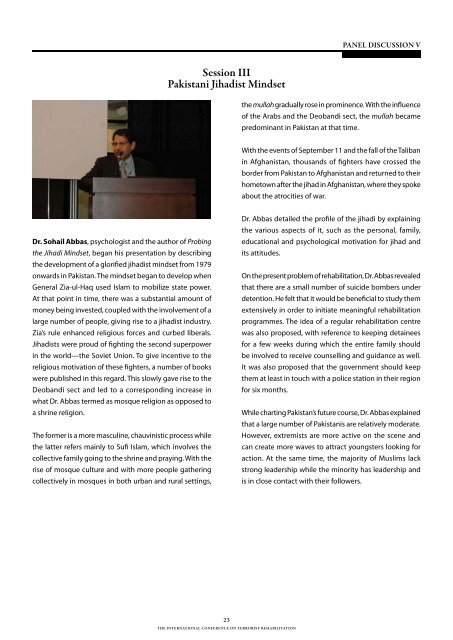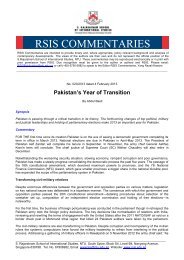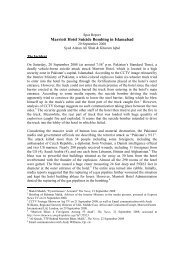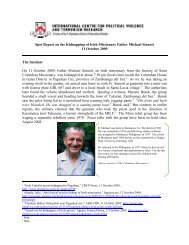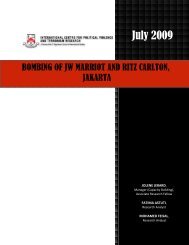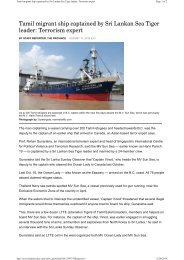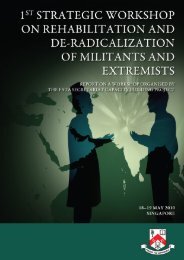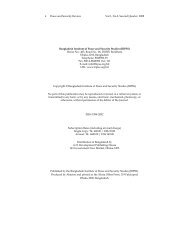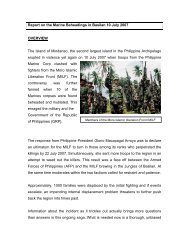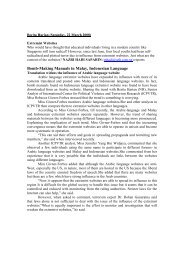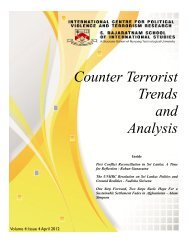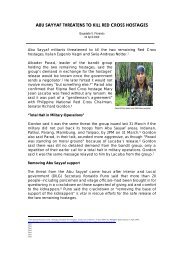International Conference On Terrorist Rehabilitation
International Conference On Terrorist Rehabilitation
International Conference On Terrorist Rehabilitation
Create successful ePaper yourself
Turn your PDF publications into a flip-book with our unique Google optimized e-Paper software.
PANEL DISCUSSION V<br />
Session III<br />
Pakistani Jihadist Mindset<br />
the mullah gradually rose in prominence. With the influence<br />
of the Arabs and the Deobandi sect, the mullah became<br />
predominant in Pakistan at that time.<br />
With the events of September 11 and the fall of the Taliban<br />
in Afghanistan, thousands of fighters have crossed the<br />
border from Pakistan to Afghanistan and returned to their<br />
hometown after the jihad in Afghanistan, where they spoke<br />
about the atrocities of war.<br />
Dr. Sohail Abbas, psychologist and the author of Probing<br />
the Jihadi Mindset, began his presentation by describing<br />
the development of a glorified jihadist mindset from 1979<br />
onwards in Pakistan. The mindset began to develop when<br />
General Zia-ul-Haq used Islam to mobilize state power.<br />
At that point in time, there was a substantial amount of<br />
money being invested, coupled with the involvement of a<br />
large number of people, giving rise to a jihadist industry.<br />
Zia’s rule enhanced religious forces and curbed liberals.<br />
Jihadists were proud of fighting the second superpower<br />
in the world—the Soviet Union. To give incentive to the<br />
religious motivation of these fighters, a number of books<br />
were published in this regard. This slowly gave rise to the<br />
Deobandi sect and led to a corresponding increase in<br />
what Dr. Abbas termed as mosque religion as opposed to<br />
a shrine religion.<br />
The former is a more masculine, chauvinistic process while<br />
the latter refers mainly to Sufi Islam, which involves the<br />
collective family going to the shrine and praying. With the<br />
rise of mosque culture and with more people gathering<br />
collectively in mosques in both urban and rural settings,<br />
Dr. Abbas detailed the profile of the jihadi by explaining<br />
the various aspects of it, such as the personal, family,<br />
educational and psychological motivation for jihad and<br />
its attitudes.<br />
<strong>On</strong> the present problem of rehabilitation, Dr. Abbas revealed<br />
that there are a small number of suicide bombers under<br />
detention. He felt that it would be beneficial to study them<br />
extensively in order to initiate meaningful rehabilitation<br />
programmes. The idea of a regular rehabilitation centre<br />
was also proposed, with reference to keeping detainees<br />
for a few weeks during which the entire family should<br />
be involved to receive counselling and guidance as well.<br />
It was also proposed that the government should keep<br />
them at least in touch with a police station in their region<br />
for six months.<br />
While charting Pakistan’s future course, Dr. Abbas explained<br />
that a large number of Pakistanis are relatively moderate.<br />
However, extremists are more active on the scene and<br />
can create more waves to attract youngsters looking for<br />
action. At the same time, the majority of Muslims lack<br />
strong leadership while the minority has leadership and<br />
is in close contact with their followers.<br />
23<br />
THE INTERNATIONAL CONFERENCE ON TERRORIST REHABILITATION


